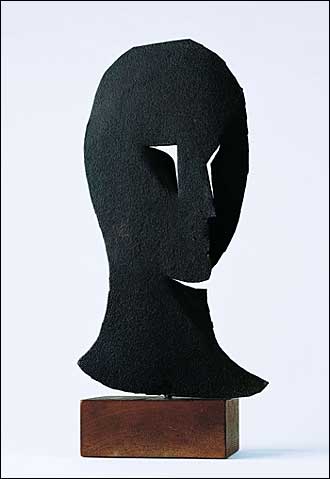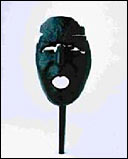
JULIO GONZALEZ, Adolescent's Mask, circa 1929-1930
Wrought iron, cut and bent, 32,6 x 17,5 x 3 cm
IVAM, Instituto Valenciano de Arte Moderno, Generalitat Valenciana,
Gift from Carmen Martinez and Viviane Grimminger © ADAGP Paris 2004 |
|
FONDATION DINA VIERNY - MUSÉE MAILLOL
59-61, rue de Grenelle
75007 Paris - France
INFORMATION:
Tel: 33 1 42 22 59 58
Fax: 33 1 42 84 14 44
Site: www.museemaillol.com
E-mail: contact@museemaillol.com
OPENING HOURS
Everyday, except Tuesdays
from 11am to 6pm
PRICES OF ADMISSION
Normal Price: 8 €
Reduced price: 6 €
Free under 16.
CURATOR
Josep Salvador
PRESS CONTACT
i&e Consultants
Claude Unger
Elisabeth Apprédérisse
Tel: 33 1 56 03 12 25
Fax: 33 1 56 03 13 00
E-mail: cunger@i-et-e.fr
eapprederisse@i-et-e.fr

|
Events dedicated to the sculptor Julio Gonzalez, one of the most important figures in the history of sculpture of the XXth century, are rare. The one dedicated to him at the Maillol museum is the first monographic exhibit organized in a museum in Paris since the retrospective at the National Museum of Modern Art in 1952. Thanks to the collaboration of the IVAM museum which possesses the most complete collection of the artist’s work, to the Centre Pompidou, the Fondation Maeght and to various private collections, the exhibit presents more than 150 works - sculptures, drawings, silver and gold works, jewels – that offer a global and representative vision of the different aspects of his work, and enhance, if need still be, his control in forging iron.
Light and shadow
In the beginning Gonzalez dedicated himself to his silversmith and artist work in his father’s workshop. His apprenticeship of metal gives him a very different approach to that of traditional sculpture based on direct cutting or modelling. He dreams of becoming a painter, and goes to the famous El Quatre Gats café, spending time with Picasso and Gargallo. But following his stay in Paris in 1900, he turns increasingly towards sculpture. His works from 1910 to 1920 remind us of certain sculptures of Maillol’s, though his style is closer to drawing than to modelling. He made still lives and strange masks, which every day further widen the gap between figuration and abstraction. Towards the end of the 20s, the shapes began to push further away from any resemblance or mimetic translation of the subject, edging towards progressive abstraction. Light and shadows are increasingly the true subjects of his sculptures. Light composes or disintegrates the face in an abstract and natural manner.

His career took a decisive turn in 1928. Picasso discovered his works done by welding, a technique which he is one of the rare artists to possess. The collaboration that follows between the two artists allowed Picasso to do Femme au jardin, 1929-30, and opened for Gonzalez a change of style that encouraged him to assert himself as a creator. His idea of the found object that loses its usual function in favour of a true poetry of forms brings him close to the Surrealists, who welcome him to exhibits together with Juan Miro or Max Ernst. Between the 1930s and the 1940s, he alternates between abstraction and sculpture in the round in which he finds a workmanship close to medieval Catalan primitivism. He makes in taglio sculptures in which the body is reduced to a shadow. He is deeply affected by the war in Spain. His Masque de la Montserrat criant becomes a mask of Greek tragedies. The mouth is an empty hole from which an endless howling escapes. He died in 1942 in Paris.
Illustration: Julio Gonzŕlez, Masque de Montserrat criant, circa 1938-1939. Bronze, 32.8 x 14.9 x 12 cm IVAM, Instituto Valenciano de Arte Moderno, Generalitat Valenciana. Photograph Juan Garcia Rosell, J.C. Pestano © Adagp, Paris
His posterity went beyond his fame
From the collaboration between Gonzŕlez and Picasso between 1928 and 1931 we remember above all the name of the author of Guernica, that of the student rather than that of the master. But art historians consider Julio Gonzŕlez as one of the first to have used iron in sculpture, and as being the inspiration of the forms that sculptors have been able to make with this new material. The posterity of his art almost seems to surpass the fame of his work. In Spain, various generations of artists inherited his influence. Sculptors such as Jorge de Oteiza, Pablo Palazuelo or Chillida have given preference to iron in their creations. Alexander Calder or David Smith have never hidden the fact that the invention of drawing in space and the use of emptiness as a component in their work had been transmitted to them by Julio Gonzŕlez’s creations. All of these major artists have been influenced in one way or another by the advance made by this small, modest man who considered himself above all as a blacksmith.
PUBLICATION:
Exhibition catalogue. Texts by Jean-Luc Daval and Josep Salvador. 150 works reproduced, 22 x 28 cm, 160 pages Co-publication Maillol Museum –Hazan. Paper cover: 35 €, ISBN: 2 85025 973
|









